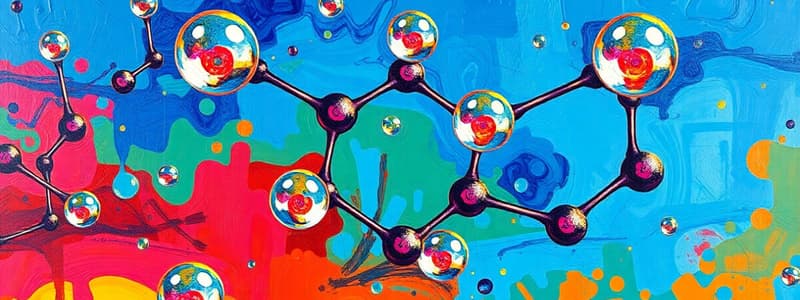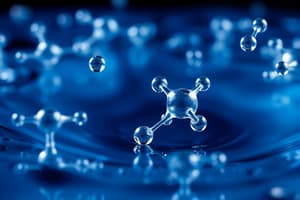Podcast
Questions and Answers
What term describes the reaction that breaks down polymers into monomers?
What term describes the reaction that breaks down polymers into monomers?
- Dehydration synthesis
- Condensation
- Hydrolysis (correct)
- Polymerization
Which of the following correctly defines the structure of a saturated fat?
Which of the following correctly defines the structure of a saturated fat?
- Has no double bonds (correct)
- Contains many double bonds
- Has one double bond
- Has only single bonds in the backbone
Which sugar is classified as a simple sugar?
Which sugar is classified as a simple sugar?
- Sucrose
- Galactose
- Fructose (correct)
- Starch
What process builds polymers from monomers?
What process builds polymers from monomers?
What characteristic of the term 'hydrophobic' best describes its relationship with water?
What characteristic of the term 'hydrophobic' best describes its relationship with water?
Which characteristic is NOT exhibited by an individual water molecule?
Which characteristic is NOT exhibited by an individual water molecule?
What type of bond involves the sharing of electrons unequally?
What type of bond involves the sharing of electrons unequally?
Which of the following statements about hydrogen ions (H+) is incorrect?
Which of the following statements about hydrogen ions (H+) is incorrect?
In Rutherford’s experiments, alpha particles were deflected due to which component of an atom?
In Rutherford’s experiments, alpha particles were deflected due to which component of an atom?
How many other atoms can a carbon atom share pairs of electrons with?
How many other atoms can a carbon atom share pairs of electrons with?
For Sodium-22, what is the correct configuration of protons, neutrons, and electrons?
For Sodium-22, what is the correct configuration of protons, neutrons, and electrons?
Which component is NOT part of a nucleotide structure?
Which component is NOT part of a nucleotide structure?
What type of aqueous solution has a high concentration of hydronium ions?
What type of aqueous solution has a high concentration of hydronium ions?
Flashcards
Water Molecule Properties
Water Molecule Properties
A single water molecule exhibits polarity, the ability to form hydrogen bonds, and heat resistance.
Ionic Bond
Ionic Bond
An ionic bond is formed by the electrostatic attraction between oppositely charged ions.
Electron Charge
Electron Charge
Electrons carry a negative charge.
Rutherford's Experiment
Rutherford's Experiment
Signup and view all the flashcards
Spheres of Hydration
Spheres of Hydration
Signup and view all the flashcards
Aqueous Solution with High H+ Concentration
Aqueous Solution with High H+ Concentration
Signup and view all the flashcards
Hydrogen Ion (H+)
Hydrogen Ion (H+)
Signup and view all the flashcards
Polar Covalent Bond
Polar Covalent Bond
Signup and view all the flashcards
Saturated fat
Saturated fat
Signup and view all the flashcards
Simple sugar
Simple sugar
Signup and view all the flashcards
Hydrolysis
Hydrolysis
Signup and view all the flashcards
Dehydration synthesis
Dehydration synthesis
Signup and view all the flashcards
Hydrophobic
Hydrophobic
Signup and view all the flashcards
Study Notes
Water Molecules
- Water molecules exhibit polarity.
- Water molecules can form hydrogen bonds.
Chemical Bonding
- Ionic bonds result from electrical attraction between oppositely charged particles.
- Covalent bonds involve the sharing of electrons.
- Polar covalent bonds involve unequal electron sharing.
- Nonpolar covalent bonds involve equal electron sharing.
Atomic Structure
- Electrons have a negative charge.
- The nucleus of an atom contains protons and neutrons.
- Rutherford's experiments demonstrated that the nucleus has a positive charge and concentrated mass.
Hydration Spheres
- Ions and polar molecules are surrounded by a hydration sphere of water molecules in liquid water.
Acids and Bases
- Aqueous solutions with a high concentration of hydronium ions are called acids.
Hydrogen Ions
- Hydrogen ions (H+) are unbound protons.
- They are the basis for measuring pH.
- They can be targets of buffers.
Atomic Structure (Specific Examples)
- Fluorine: 9 protons, 10 neutrons, 9 electrons
- Sodium-22: 11 protons, 11 neutrons, 11 electrons
- Lithium ion (Li+): 3 protons, 4 neutrons, 2 electrons
- Iron: 26 protons, 30 neutrons, 26 electrons
- Barium ion (Ba2+): 56 protons, 81 neutrons, 54 electrons
Chemical Bonds and Atoms
- Carbon atoms can form four covalent bonds.
Protein and Nucleic Acid Structure
- Denatured proteins and DNA have lost their three-dimensional structure and function.
- Nucleotides compose nucleic acids (e.g., DNA, RNA). Nucleotides contain a phosphate group, a ribose sugar, and a nitrogenous base.
- Amino acids are the building blocks of proteins.
- Hydrogen bonds maintain the three-dimensional structure of proteins and nucleic acids.
Lipids
- Saturated fats have no double bonds in their fatty acid tails.
- Lipids primarily function in energy storage.
Carbohydrates
- Glucose is a simple sugar.
- Starch, sucrose, and lactose are complex carbohydrates.
Chemical Reactions
- Hydrolysis is a breakdown reaction that involves the addition of water.
- Dehydration synthesis creates polymers from monomers by removing water.
Water Properties
- Water exhibits cohesion.
- Water is an excellent solvent.
- Water organizes hydrophobic molecules.
- Water has a relatively high specific heat.
Studying That Suits You
Use AI to generate personalized quizzes and flashcards to suit your learning preferences.
Description
This quiz covers fundamental concepts in chemistry, including the properties of water molecules, types of chemical bonding, and atomic structure. You'll explore topics like hydration spheres, acids, and the significance of hydrogen ions. Test your understanding of these essential principles in chemistry!




